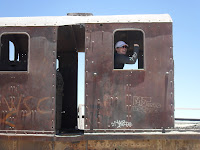Pitch black on the outskirts of a town with no streetlights we woke up at 3:30 in the morning on the last day of our tour. We’re lucky that we had such a good driver. He didn’t speak much, and he didn’t know any English, but he drove safely. More people die on the Salar de Uyuni tour than the Death Road near La Paz every year because too often drivers are reckless or even intoxicated on roads that don’t exist. But our driver was excellent in the desert night, feeling his way over the rough terrain cautiously, as the gloaming revealed the silhouette of a ridge on our left and a plain on our right. After an hour of driving we reached the edge of white ground. The sky was lighting quickly and we were worried that we would miss the sunrise proper, but we were right on time. We stopped in the middle of the salt flat, any distance was impossible to determine, the horizon was as flat as the ocean, and the sun rose like molten metal being poured upward into a perfect invisible mold.
It was truly too early for this. Up at 3:30, in front of the sunrise until about 6 am, we still hadn’t eaten breakfast, but somehow the altitude decreases your appetite as does the frigid air. We drove across the flats to Incahausi, an island of rock in the center of a long dry sea of salt. It has big saguaro cacti, seriously. We took a half hour hike around the island and came back to a basic breakfast of bread, butter, jam, and tea. There were also llamas. It seems ridiculous for llamas to be there because the nearest non-salt-flat land had to be over 50 kilometers away, but again, it’s impossible to tell how far away anything is on the Salar.
When we got back in the car, we stopped on the other side of the island and took pictures. The far edge of the Salar was not visible, which proved to be the point. On a white space without any objects to give the eye perspective, many photographic tricks are possible and we amused ourselves by exploring the possibility for hours. We had so much time because another 4x4 had broken down, the one that Kev and Alison were on, right where we were set to take pictures and our driver and the other driver for our tour group were helping their driver fix the vehicle. It took a very long time for them to fix it.
So we were a little late since we had decided to wake up for the sunrise and were supposed to be in Uyuni at about midday, we were now on schedule to arrive in Uyuni as if we hadn’t woken up for the sunrise, at about 3pm. This will prove to be very important. We sailed across the salar, stopping briefly at a small place with many flags and a village with a market where we bought two small pieces of salt for about 15 cents.
The outskirts of Uyuni are covered in plastic bags blown by the wind and caught on desert brush. And then you come to the train graveyard, covered in the same trash that covers the desert around it. The rusty piles of metal resting on warped tracks are the town proper’s greatest attraction. They’re bizarre and dangerous looking and covered in graffiti that ranges from the banal to the intellectual. Amanda climbed on them and acted like a train conductor, but I don’t know if I’m still officially immunized for tetanus so I declined.


On to Uyuni, the driver, since we didn’t arrive at a reasonable hour, billed the tour company for lunch at an almuerzo familiar place above the immigration office (bizarre right), which was alright. It was simple, first quinoa soup, then some meat in sauce and rice. We went around the corner to check into our hostel, the cheapest place we’ve stayed in, only 14 dollars a night for both of us in a private room sharing a bath. Then since we were still illegal in Bolivia because we’re shifty Americans and the only nationality that needs a visa which costs 135 dollars to enter the country, we went to the only ATM in town. No dice. It’s Saturday. That means that it won’t be fixed until the bank opens again on Monday. So instead of heading off to Sucre on Sunday, we were stuck in Uyuni after the immigration officer, who was a very nice man, locked our passports in a safe at the immigration office. We rested in Uyuni and on Monday when the ATM was fixed there was a line across the street, and we only had an hour to get money, get a visa, and get on the bus to Sucre at 10. I waited in line, as Amanda went to the immigration office to fill out the paperwork, when I finally got money I sprinted there. They put our visa in our passports with time to spare and we were off to Sucre after showing off the skills that would make us favorites if we were ever on The Amazing Race.






No comments:
Post a Comment